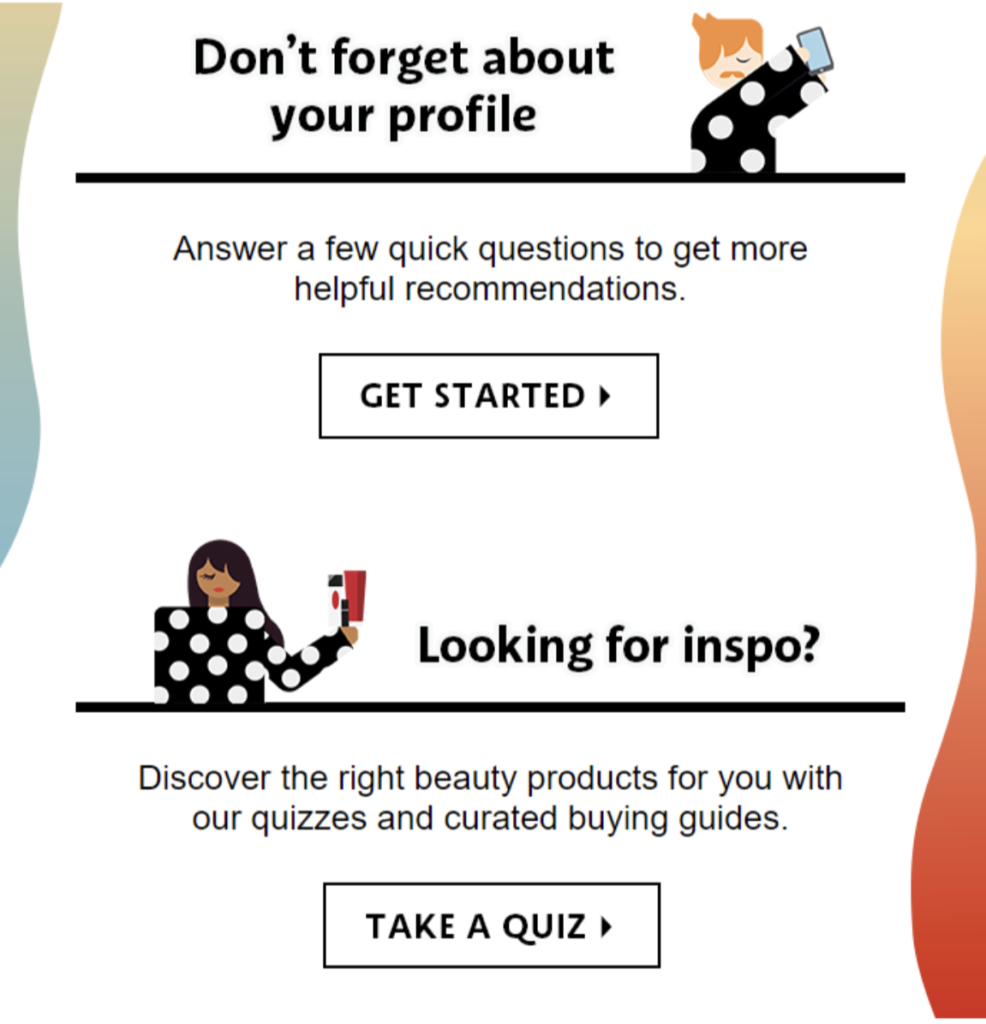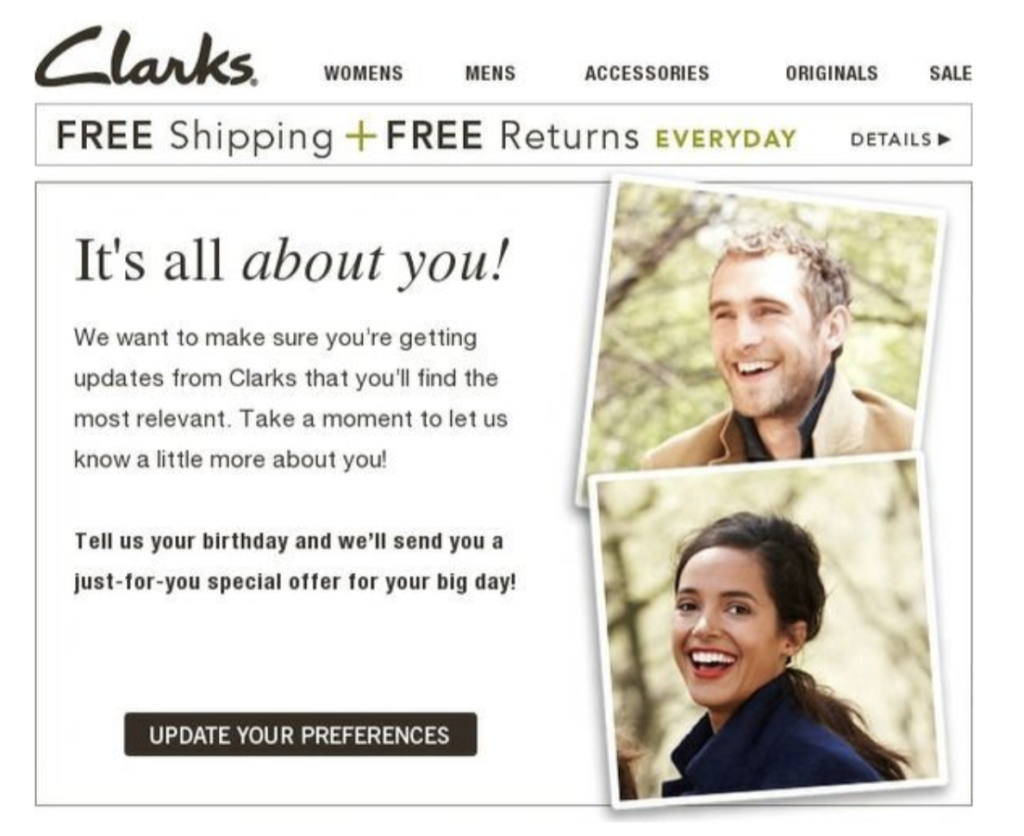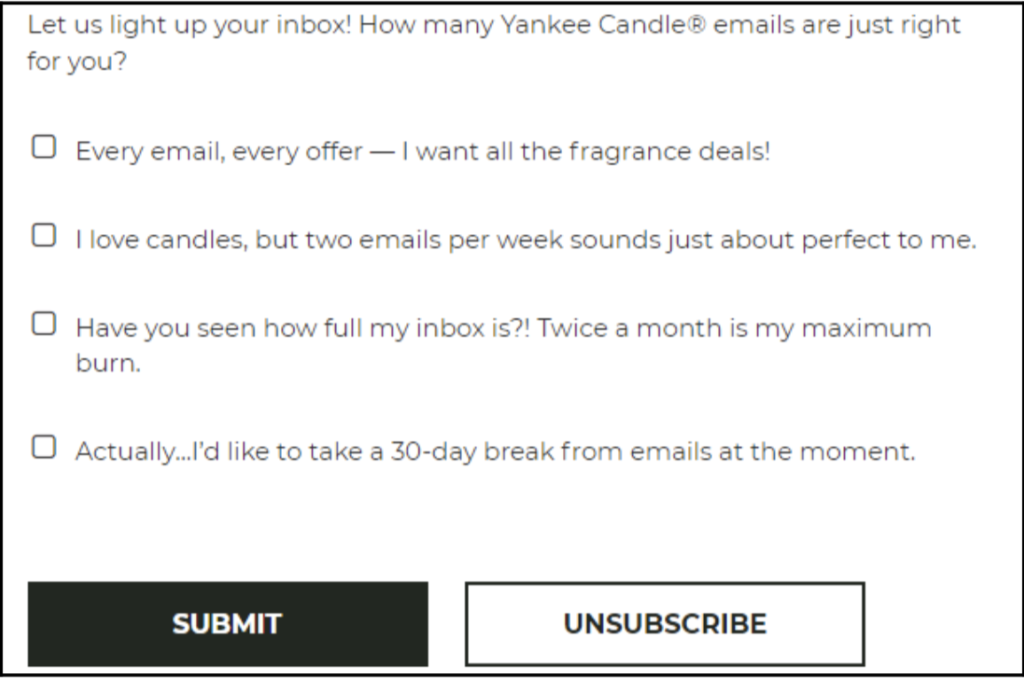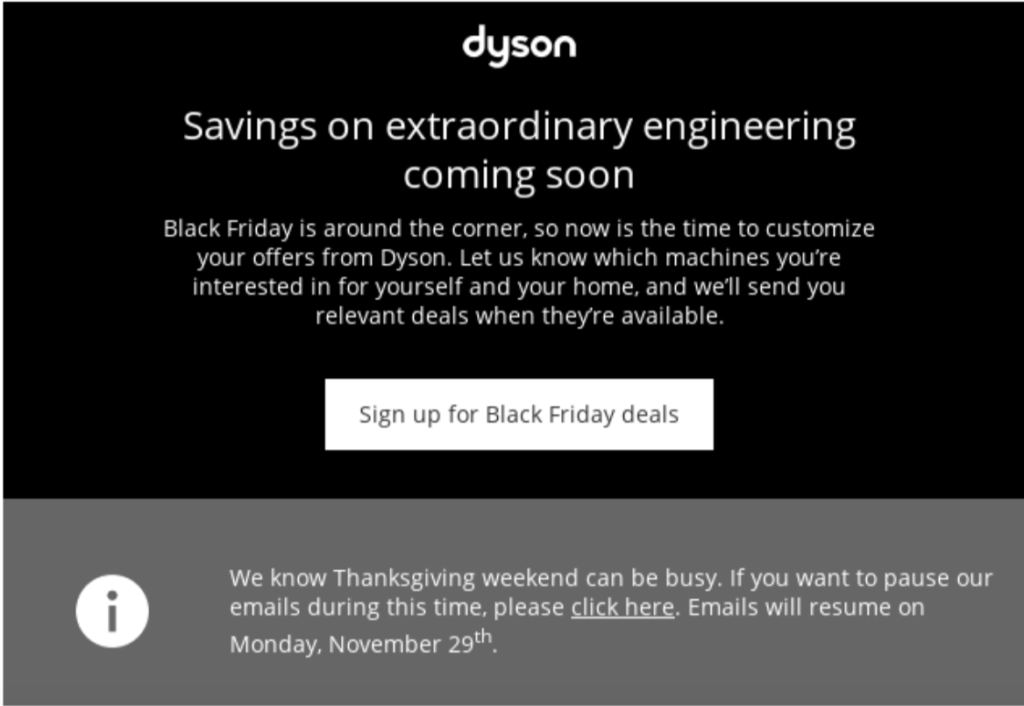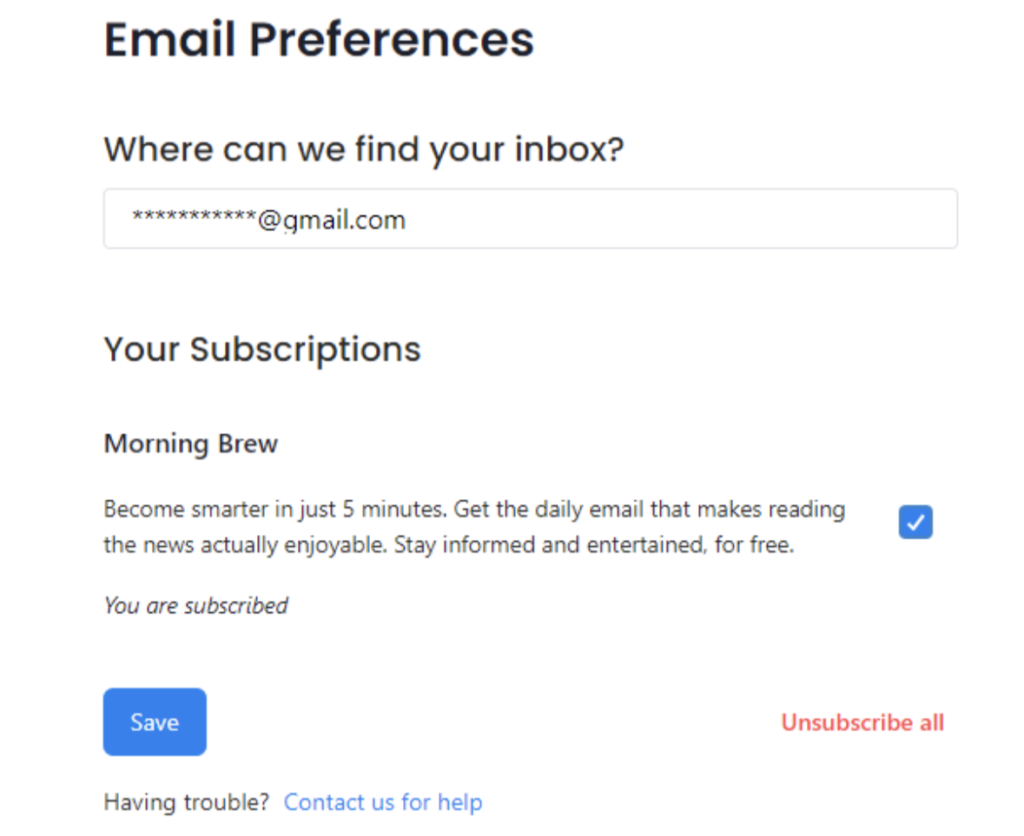
Email preference centers: Everybody has them, but few senders take the time to build them in ways that drive meaningful improvements to their marketing efforts.
Let’s start with the basics: An email preference center is a landing page that subscribers can use to make choices about the emails they’ll receive. The simplest preference centers provide options for the frequency of mailings, the type of messaging sent (promotions, newsletters, etc.), and subscribers’ preferred email addresses.
Why is any of this important for senders? Apple’s Mail Privacy Protection (MPP) is already making engagement measures like open rates less reliable, and Google plans to stop supporting third-party cookies in 2023. Without those traditional tracking tools, marketers increasingly need to rely on information provided directly by customers to create relevant and engaging content.
Additionally, audiences are growing distrustful of brands and more cautious about the information they share. But at the same time, they expect personalized shopping experiences. In this climate, marketers need tools like preference centers to create authentic, customized experiences subscribers can trust.
Taking your email preference center to the next level doesn’t have to be hard. Follow a few guidelines to get started, and you’ll have a preference center that helps minimize unsubscribes and delivers experiences that drive brand loyalty.
1. Make the Preference Center Easy to Find
This may seem like common sense, but if you want people to share their preferences you should make the process simple. Don’t force your audience to search high and low for your email preference center.
Every email should include a link that invites subscribers to update their preferences. The call to action can be as simple as, “Update your preferences” or you can have fun with something like, “Tell us what you want, what you really, really want.” Just keep it on brand and make it clear why you’re asking for details.
Consider making the link more prominent by placing it in the header of your email template. Historically, senders hid preference center links in email footers along with unsubscribe and privacy policy links. If you’re serious about making your consumer outreach more relevant, try something different by putting the preference center near the top.
2. Gather Preferences During the Onboarding Process
Start your email conversation on the right foot by collecting preferences immediately when customers subscribe. By gathering interests up front, you’re more likely to delight subscribers from the start with content they’ve told you they want. They’re also less likely to mark your email as spam or unsubscribe due to disappointment.
Lululemon does a great job determining interests by showing a list of choices as soon as customers hit the “subscribe” button.
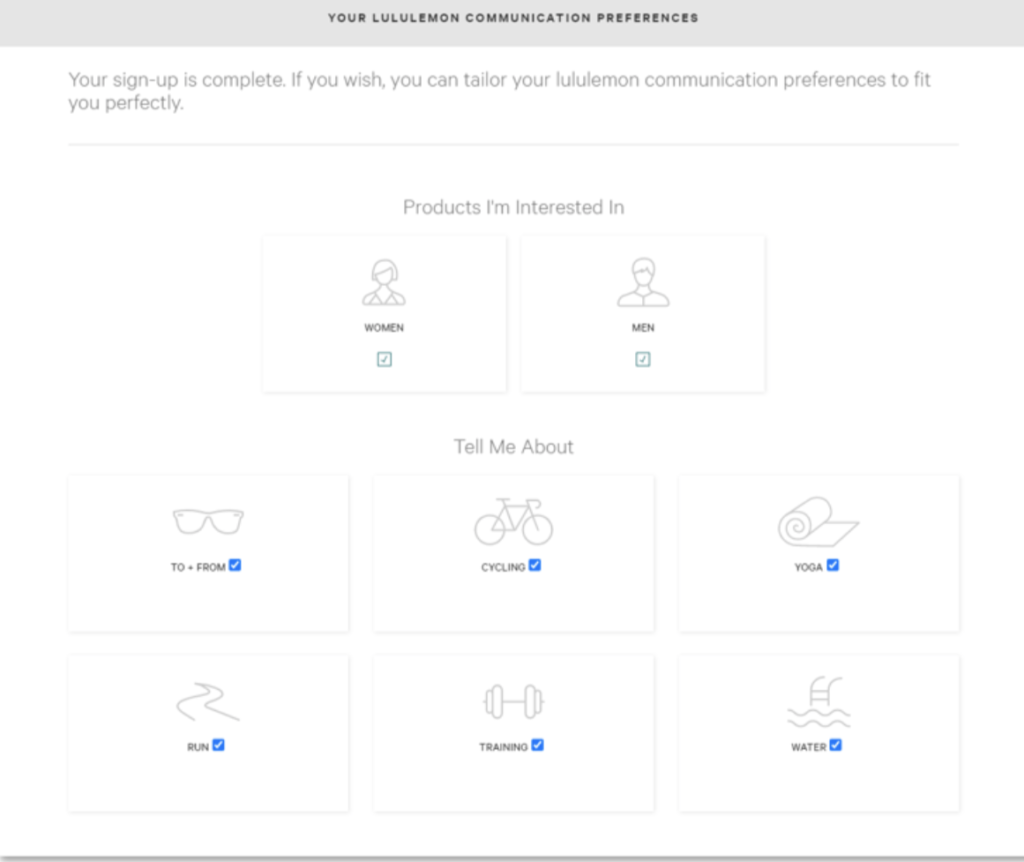
The list is brief and specific to Lululemon’s product offerings. Choices for “Women” or “Men” ensure that subscribers only see clothing they’ll wear. Additional options suggest that they’ll be shown products related to their favorite activities.
If you can’t immediately determine audience desires, your welcome journey is another opportunity to gather their interests before new subscribers join your regular mail stream.
Sephora collects preferences in various ways through their welcome series emails. First, they ask new subscribers to answer a few questions to get better product recommendations. Second, they gamify the preference process by inviting customers to take a quiz to determine what they’re most likely to buy.
These methods make it easy—and occasionally fun—for customers to share their interests from the get-go. They also help increase click-throughs by getting product recommendations correct from the very beginning.
3. Promote the Preference Center Through Email
Sometimes when you want to know something, you just need to ask. If you’re serious about gathering customer choices, feature the email preference center in one of your regularly scheduled marketing campaigns.
Customers are increasingly concerned about privacy, so it can be helpful to let subscribers know they’ll receive something in return for sharing their information. The benefit doesn’t have to be a discount (although those are always nice). If you primarily send newsletters, consider offering subscribers an exclusive article or white paper in return for their details.
Clarks reminds their subscribers that sharing preferences results in more relevant messages. They also provide a benefit, letting subscribers know they’ll receive special birthday offers if they provide their birth dates.
The message is also clear in its call to action. The “Update Your Preferences” button is prominent and specific, which keeps it from getting lost among other offers or links.
4. Make Opt-Down an Option
When the Data & Marketing Association (DMA) asked consumers why they unsubscribe, the most popular response was, “I receive too many emails!” You can reduce subscriber fatigue by giving customers control over the amount of messages they receive. Opt-down options limit the frequency of your mailings to a level your audience prefers.
Sending emails daily may be too much for some subscribers. Consider providing options for a weekly or biweekly frequency. Yankee Candle gives their customers plenty of choices to get their frequency just right.
Notice that they also give subscribers the option to take a 30-day break from emails. The “snooze” feature is an increasingly popular way to limit unsubscribes.
Dyson took snooze to the next level by letting subscribers pause email during the Black Friday email blitz.
The snooze feature can be useful all year, depending on the products you sell. Someone who recently went through a bad breakup may want to pause Valentine’s Day emails. Families that have lost children may not want to see a series of back-to-school messages. Letting customers pause emails is a thoughtful way to let them set the pace.
While email teams are always pushed to send more, it’s important to give subscribers the option to take a break. Getting the frequency right also helps reduce complaints, which helps sender reputation and deliverability. Some senders have even seen unsubscribes decrease by as much as 82 percent when offering snooze options.
5. Enable Subscribers to Easily Update Their Addresses
Some preferences aren’t about the content you send. For instance, subscribers may get a new address or change where they want messages sent. Your preference center should provide the option to update their email addresses.
Allowing address updates helps to reduce bounces, which is good for your sender reputation. Plus, workforce shifts like the Great Resignation have resulted in huge numbers of people changing jobs, and in turn, changing email addresses. In this climate, up-to-date email addresses are more valuable than ever.
Morning Brew puts the address field at the top of their email preference center, above a list of newsletters subscribers receive. This makes it easy to change where email is sent and manage subscriptions all in one location.
6. Follow Through
OK, a subscriber told you their product preferences. They said they only want two emails per month. Maybe they shared their birthday. It feels like you’re in a healthy relationship. Don’t accidentally end it by ignoring these details!
Following through with personalized, custom content is something subscribers now expect. If your audience tells you they want more newsletters, be prepared to generate regular content updates. When they share their birthdays, make sure you celebrate with special offers.
Plan which messages you’ll send to the opt-down audience so they only receive your best offers, or content you know they’re likely to click. For subscribers that snooze Black Friday messaging, consider asking if they’d like to do it again next year.
Don’t forget to combine email preference center choices with other first-party data, such as purchase history. For example, customers may tell you they want to see more yoga mats. But if you know they also purchase water bottles 80 percent of the time, don’t hesitate to make that cross-sell recommendation.
Conclusion
Creating (and using) an email preference center can help you deliver authentic, personalized messages that subscribers of any age genuinely want to receive. Listen to your audience and you’ll be rewarded with higher engagement and more satisfied customers.
The new spotlight on preference centers is just one effect of MPP.
To learn more about MPP and how email marketers can adapt, read our eBook, “What the Heck is Mail Privacy Protection?“
